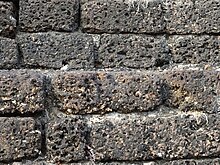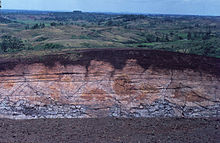Laterite

Laterite (from Latin later "brick") is a surface product that occurs frequently in tropical areas and is caused by intensive and long-lasting weathering of the underlying rock. Laterite dried in the air is used as a building material in some parts of the world . A very similar rock with a lower iron / hematite content is called bauxite ; there is a continuous transition in possible chemical compositions between the two rocks.
Demarcation
In the geosciences , only those weathering products that have been modified the most from a mineralogical and chemical point of view are called laterite; the less weathered, but often very similar looking and most widespread in the tropics and subtropics surface formations, however, as saprolite . Both weathering formations can be classified as residue or residual rocks.
In soil science there are separate names for laterites. The international soil classification World Reference Base for Soil Resources (WRB) calls soils with laterite plinthosols . In the USDA Soil Taxonomy , they mostly belong to the oxisols .
Origin and composition

Depending on the composition of the parent rock and the degree of weathering, laterites are either soft to crumbly or hard and physically resistant.
The rocks on the earth's surface are deeply decomposed under the influence of the high temperatures and precipitation of the tropics, whereby the minerals occurring in the parent rocks are largely dissolved and sands are washed out. During this chemical weathering, a high proportion of the more easily soluble elements sodium , potassium , calcium , magnesium and silicon (silicic acid) is carried over into the seeping rainwater , which leads to a strong accumulation of residues of the less soluble elements iron and aluminum ( ferrallitization ).
In addition to the poorly soluble quartz from the original rock, laterites mainly consist of the minerals kaolinite , goethite , hematite and gibbsite (hydrargillite) newly formed during weathering . The iron oxides goethite and hematite cause the mostly red-brown color of the laterites, which are mostly only a few meters thick, but can also reach significantly greater thicknesses.
Occurrence
Laterites formed over almost all types of rock in areas that do not have a strong relief , so that the weathering cover was preserved and did not fall victim to erosion . Laterites in today's non-tropical climates are a product of earlier geological epochs.
Deposits in laterites
Lateritization is particularly important for the formation of lateritic deposits. Bauxites are aluminum-rich laterite varieties that can form from many rocks if the drainage is particularly intensive. This causes a very strong removal of silicon and a correspondingly high concentration of aluminum, in particular as hydrargillite. The lateritization of ultramafic rocks ( serpentinite , dunite , peridotite with 0.2–0.3% Ni) can lead to a significant nickel enrichment. A distinction must be made between two types of lateritic nickel ores: A very iron-rich Ni- Limonite ore on the surface contains 1–2% nickel bound to goethite, which is highly enriched due to the extensive dissolution of silicon and magnesium. Below this zone there is nickel-silicate ore in some deposits with often more than 2% Ni, which is bound in silicates, especially serpentine . In addition, small amounts of green garnierite are excreted in pockets and on crevices of the serpentinite , but mostly with a very high nickel content of 20–40%. This is a mixture of different Ni-rich sheet silicates . All of the nickel present in the silicate zone was loosened from the overlying goethite zone and relocated in a descending manner. The absence of the goethite zone is due to erosion.
history
Laterite has always been used as a building material in India and the Southeast Asian countries. For example, the well-known temple complexes in Sukhothai in Thailand and Angkor in Cambodia were built from laterite stones.
Francis Buchanan-Hamilton was the first to describe the material in his travelogue from Madras and the surrounding countries. Derived from the Latin word later "brick", he suggested the name laterite for the material . This name was quickly adopted by English literature and spread around the world.
Dismantling and use
The mining of laterite is done by hand or with the help of machines in quarries. The laterite stones obtained in this way are suitable for building walls and ceilings due to their strength. Harder laterites are also used in broken form for the construction of roads (so-called laterite slopes).
Laterite gravel is also popular in aquariums, where it is said to have a beneficial effect on the growth of tropical plants.
Laterite Monument in honor of Francis Buchanan-Hamilton, Thiruvananthapuram , Kerala, India
Road in Misiones Province , Argentina
literature
- GJJ Aleva (Ed.): Laterites. Concepts, Geology, Morphology and Chemistry . ISRIC, Wageningen 1994, ISBN 90-6672-053-0 .
- G. Bardossy and GJJ Aleva: Lateritic Bauxites . In: Developments in Economic Geology . tape 27 . Elsevier, Amsterdam 1990, ISBN 0-444-98811-4 .
- JP Golightly: Nickeliferous Laterite Deposits . In: Economic Geology . tape 75 , 1981, pp. 710-735 .
- W. Schellmann: Geochemical Principles of Lateritic Nickel Ore Formation . In: Proceedings of the 2nd International Seminar of Lateritization Processes . Sao Paulo 1983, p. 119-135 .
Web links
- Werner Schellmann: An Introduction in Laterite . Retrieved April 23, 2009.
Individual evidence
- ^ Francis Buchanan: A Journey from Madras through the countries of Mysore, Canara and Malabar ... Volume 2 . T. Cadell and W. Davies (Booksellers to the Asiatic Society); Black, Parry, and Kingsbury (Booksellers to the East India Company), London 1807, pp. 440, 441 ( full text in Google Book Search).
- ^ Edgar Thurston: The Madras Presidency with Mysore, Coorg and the Associated States . In: Thomas H. Holland (Ed.): Provincial Geographies of India . Cambridge University Press, London 1913, pp. 65 ( archive.org ).







